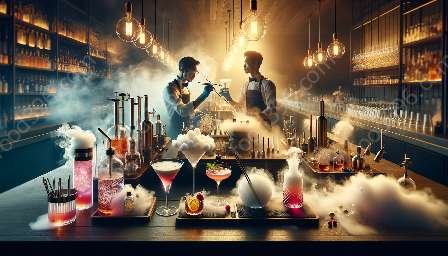Creating foam in cocktails is not just about visual appeal; it can significantly impact the taste and texture of a drink, elevating the overall drinking experience. In the world of mixology, particularly in the realm of molecular mixology, understanding foam formation is essential for crafting innovative and visually stunning cocktails that tantalize the taste buds.
Molecular Mixology and Cocktail Culture
Molecular mixology, a branch of mixology that focuses on the scientific principles behind cocktail-making, has gained significant popularity in recent years. It combines the art of mixology with the science of chemistry and physics to create unique, avant-garde cocktails that push the boundaries of traditional drink recipes.
As part of the broader cocktail culture, molecular mixology brings a fresh perspective to the way cocktails are conceptualized, prepared, and enjoyed. By delving into the intricacies of foam formation and its role in enhancing the sensory experience of a cocktail, mixologists can unlock an array of creative possibilities.
The Science of Foam Formation
Foam in cocktails is formed through a process known as 'aeration,' which involves incorporating air into a liquid to create a stable, frothy texture. Molecular mixologists employ various techniques and ingredients to achieve this, including the use of foaming agents, emulsifiers, and carbonation.
One of the key factors in foam formation is the stability of the bubbles, which influences the longevity of the foam and its visual appeal. Through the careful manipulation of ingredients and the application of scientific principles, mixologists can control the size, density, and texture of the foam, ultimately shaping the overall drinking experience.
Enhancing Aesthetics and Flavors
Foam formation not only adds a visually captivating element to cocktails but also plays a crucial role in flavor delivery. The foam serves as a vessel for encapsulating aromatic compounds, allowing for a heightened olfactory experience with each sip. This is particularly important in molecular mixology, where the emphasis is on creating multisensory cocktails.
Furthermore, the texture and mouthfeel of the foam can contribute to the overall drinking sensation, creating a more dynamic and engaging palate experience. By leveraging the science of foam formation, mixologists can elevate the flavors of a cocktail while simultaneously captivating the senses through innovative presentation.
Experimental Techniques and Ingredients
Within the realm of molecular mixology, experimentation is key, and mixologists are constantly exploring new techniques and ingredients to achieve unique foam formations. From utilizing siphons and nitrous oxide to introducing unconventional foaming agents such as soy lecithin or xanthan gum, the options for creating innovative foams are diverse and dynamic.
Additionally, the interaction between different cocktail components, such as acids, sugars, and spirits, can influence the formation and stability of foam. Understanding these interactions at a molecular level empowers mixologists to craft cocktails that are not only visually striking but also profoundly complex in flavor and texture.
Immersive Guest Experience
For bartenders and mixologists, leveraging foam formation in cocktails offers an opportunity to engage guests on a deeper level. By showcasing the science and artistry behind molecular mixology, mixologists can capture the curiosity and imagination of patrons, creating a memorable and immersive drinking experience.
Through hands-on demonstrations or interactive presentations, mixologists can illustrate the intricate process of foam formation, providing guests with a glimpse into the alchemy of cocktail creation. This not only adds a layer of entertainment to the drinking experience but also fosters a deeper appreciation for the craftsmanship involved in molecular mixology.
Pushing Boundaries and Evolving Trends
The intersection of molecular mixology and cocktail culture continues to drive innovation within the industry. Mixologists are constantly pushing the boundaries of traditional cocktail-making, seeking to surprise and delight patrons with increasingly inventive and visually stunning creations.
As foam formation becomes a central focus in cocktail experimentation, mixologists are tapping into the principles of molecular gastronomy and culinary arts to develop cutting-edge foam-based cocktails. This integration of scientific knowledge and artistic flair exemplifies the evolution of cocktail culture, providing an ever-changing landscape of taste, presentation, and experience.
Conclusion
Understanding the intricate relationship between foam formation, molecular mixology, and cocktail culture unveils a world of possibilities for both seasoned mixologists and cocktail enthusiasts. By embracing the scientific nuances of foam creation and its impact on sensory perception, the art of crafting cocktails is elevated to new heights, reshaping the way we appreciate and indulge in the captivating realm of mixology.

